Panasonic Lumix S 14-28mm F4-5.6 MACRO review
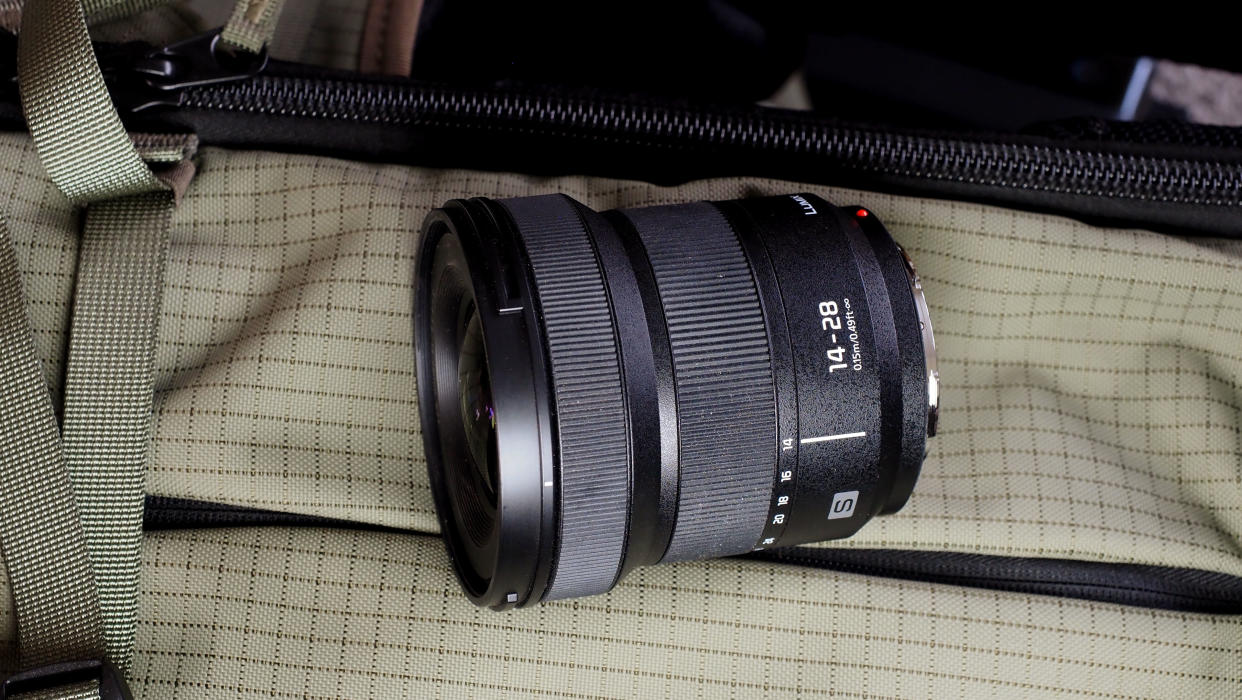
Ultra-wide zooms are very popular amongst landscape, travel and architectural photographers for their ability to squeeze everything into the frame even when you’re right up close. They are also useful for filmmakers and vloggers who need to film themselves at arm’s length and get the background surroundings into the frame too.
However, ultra-wide zooms for the best full frame cameras are typically big, heavy and expensive. Either that, or their performance is only mediocre. The Lumix S 14-28mm F4-5.6 MACRO really turns that on its head. It’s not very expensive, but it is rather good. In fact, for anyone trying to keep the costs down, it's got to be one of the best L-mount lenses to get.
Here are a few reasons why. First, it has a macro capability… well, sort of. It can offer 0.5x magnification at its maximum focal length of 28mm, and while that’s not a true 1:1 macro magnification, it still gets you a lot closer to small objects than a regular lens.
Second, by full frame zoom standards, this is not a big lens. It’s about the same size as Panasonic’s f/1.8 primes and the Lumix S 20-60mm kit zoom. Better still, it’s designed not to change length during use, so once it’s balanced on a gimbal, it should stay balanced. This makes it ideal for use on the Panasonic Lumix S5 II and Lumix S5 IIX, two of the best hybrid cameras right now.
It’s dust, splash, and freeze resistant, it has fast and silent AF actuators for video as well as stills photography, and it takes 77mm filters – unlike many ultra-wide lenses in this range, it doesn’t use a fixed petal-shaped lens hood, so using filters won’t be a problem.
On the downside, it has a modest 2x zoom range – but then there are plenty of modern ultra-wide zooms that don’t even offer this – and the f/4-5.6 maximum aperture looks a little weak too. But then, if that’s what it takes to keep the size and the cost down, maybe it’s worth it.
The key factor will be the optical performance. We can forgive a lot of things if a lens delivers really good results.
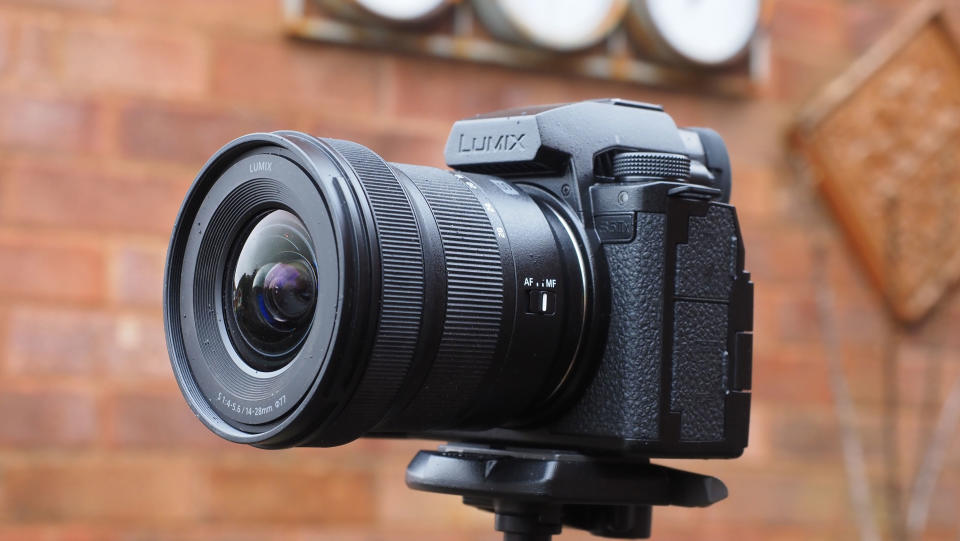
Panasonic Lumix S 14-28mm F4-5.6 MACRO: Specifications
Panasonic Lumix S 14-28mm F4-5.6 MACRO: Price and availability
The Lumix S 14-28mm F4-5.6 is on sale now, costing around $698 / £699. No, that’s not a mistake, that’s really what it costs. The variable maximum aperture obviously needs to be taken into account, but a 1 f-stop drop at full zoom is not much, and this lens really does look like great value. The Lumix S camera range doesn’t just include some powerful, competitively priced cameras, it also has a good choice of affordable and highly competent lenses.
Panasonic Lumix S 14-28mm F4-5.6 MACRO: Design and handling
The Lumix S 14-28mm F4-5.6 is about as plain as you can get, but that is the style of Panasonic’s Lumix S lenses. There’s a zoom ring, a focus ring, an AF-MF switch and that’s it. There’s no focus distance scale and no physical aperture ring, de-clickable or otherwise.
Is that a bad thing? Maybe not. There’s no fuss, no complication, just a plain and basic lens design with the aperture controlled from the camera body.
This is not an expensive lens, but it does feel well-made. The zoom and focus rings turn smoothly and the weather sealing is reassuring to have – and good to get in a lens at this price.
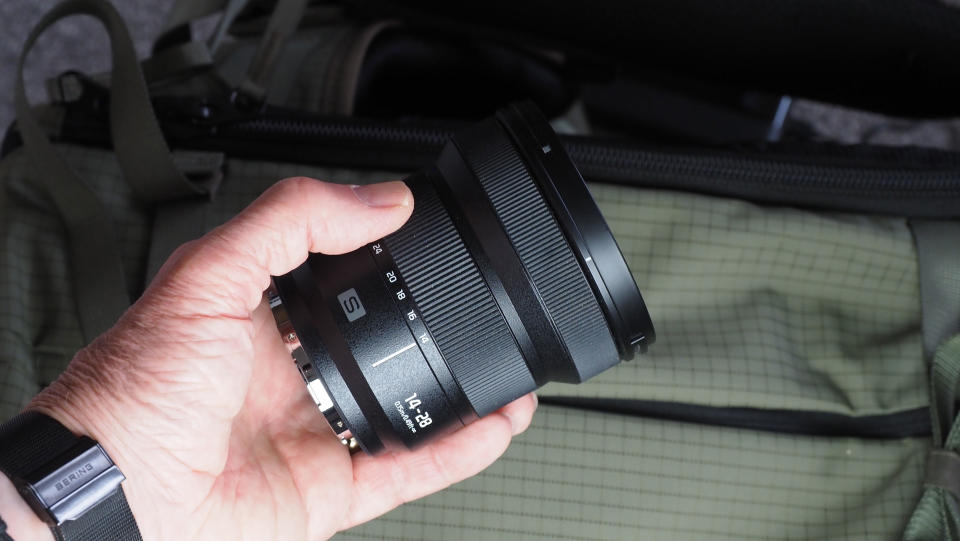
The most noticeable thing is the size. This is a very compact lens for an ultra-wide full-frame zoom, and while the penalty is a more restricted f/5.6 maximum aperture at the 28mm end of the zoom range, I for one would be perfectly happy to accept that in exchange for the compact size, lightweight and highly agreeable price!
The Lumix S 14-28mm F4-5.6 is a little boring to look at and use, but that’s not going to bother practically-minded photographers who just want a lens to do its job. It’s also very close in size to Panasonic’s f/1.8 prime lenses and the 20-60mm kit lens. They make a very cohesive lens collection that could appeal to stills photographers and videographers alike.
Panasonic Lumix S 14-28mm F4-5.6 MACRO: Performance
Zoom lenses often lose optical quality at the longer end of the range, especially ultra-wide zooms, but the Lumix S 14-28mm F4-5.6 holds up extremely well. The lab tests confirm the impressions you get from real-world photography, and this is a lens you can use at any focal length and any aperture without worrying about any dip in image quality.
The corner sharpness is typically lower than the center sharpness, but it’s never less than good, even wide open. 24mm is probably the weakest focal length for edge sharpness, but even here you’d have to do some fairly intense pixel-peeping to see the difference. Otherwise, this is a lens that reliably delivers good visual edge-to-edge sharpness, whatever the aperture or zoom setting. It’s an excellent performance for a lens at this price point, and you would have to pay a lot more for professional optics to improve on what this lens can do.
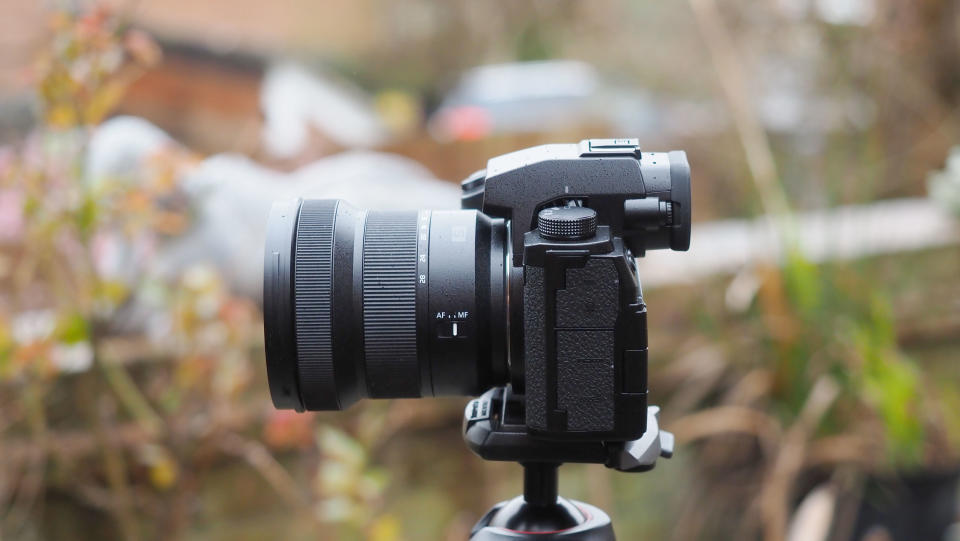
The explanation might lie in the optical construction, which is actually quite sophisticated, consisting of 14 elements in 10 groups and includes an aspherical ED element, a regular aspherical element, three ED glass elements, and one UHR (ultra-high refractive) element. Thanks to the digital lens corrections applied in-camera and by programs like Lightroom, there’s no visible distortion, corner shading, or color fringing.
The autofocus performance is impressive too. It’s fast, essentially silent, and perfect for video as well as stills photography. What’s more, the extra wide 14-28mm focal range is handy for selfie-vlogging on a gimbal or grip.
Panasonic Lumix S 14-28mm F4-5.6 MACRO: Sample images






Panasonic Lumix S 14-28mm F4-5.6 MACRO: Lab results
We run a range of lab tests under controlled conditions, using the Imatest Master testing suite. Photos of test charts are taken across the range of apertures and zooms (where available), then analyzed for sharpness, distortion and chromatic aberrations.
We use Imatest SFR (spatial frequency response) charts and analysis software to plot lens resolution at the center of the image frame, corners and mid-point distances, across the range of aperture settings and, with zoom lenses, at four different focal lengths. The tests also measure distortion and color fringing (chromatic aberration).
Sharpness:
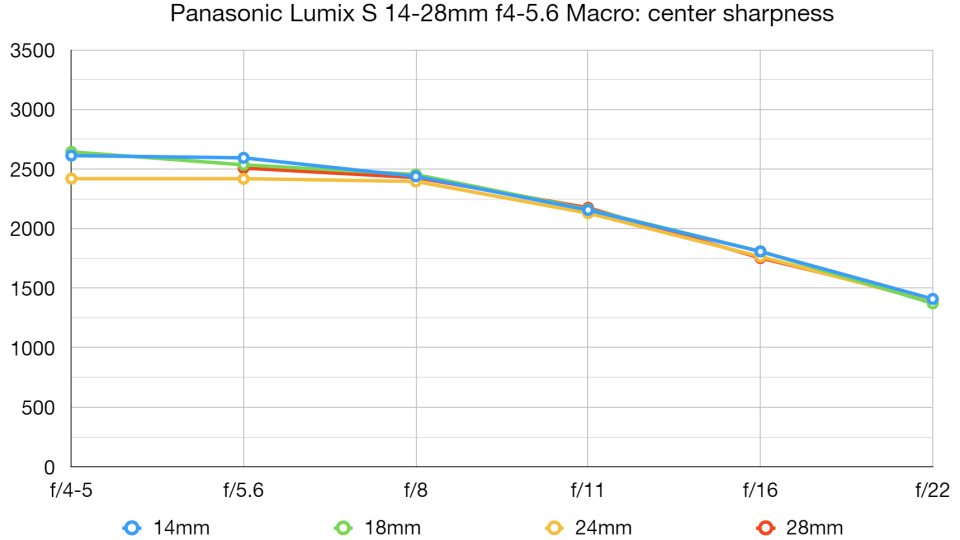
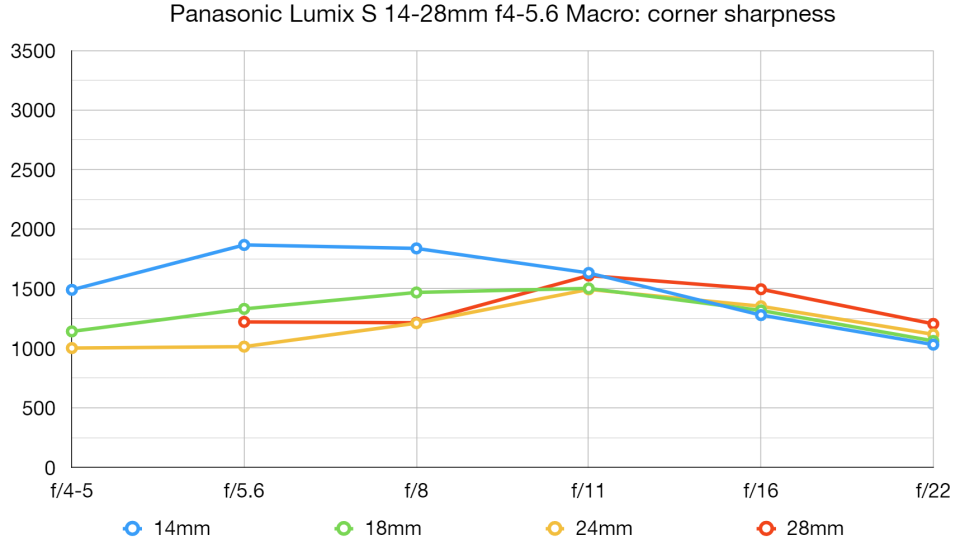
Center-sharpness is impressive and remarkably consistent throughout the entire zoom range. Corner sharpness is more of a mixed bag, being excellent at 14mm, but more lacklustre as you zoom in. At longer focal lengths you'll need to stop down to f/11 to get the best sharpness right into the corners.
Fringing:
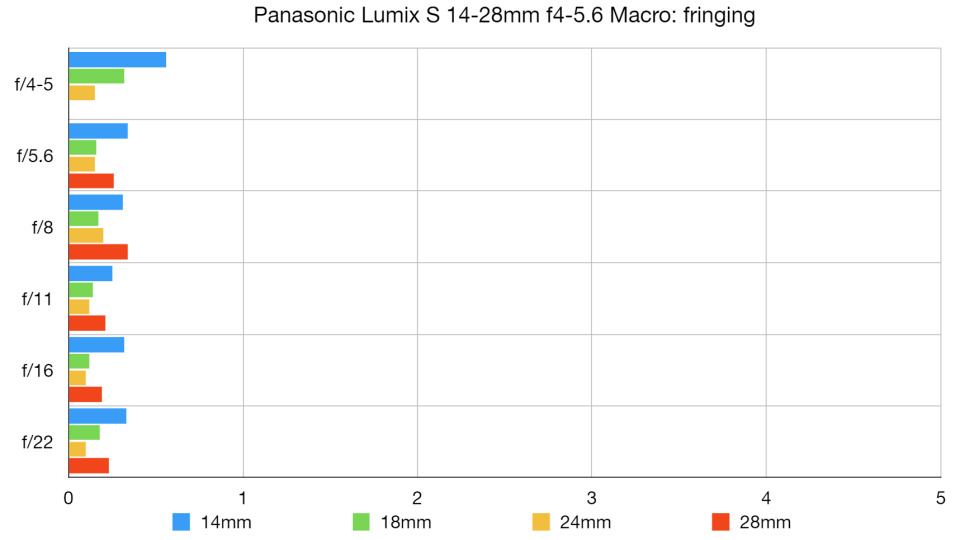
Color fringing is very well controlled at all focal lengths and apertures - the lens never produces any hint of aberrations.
Distortion:
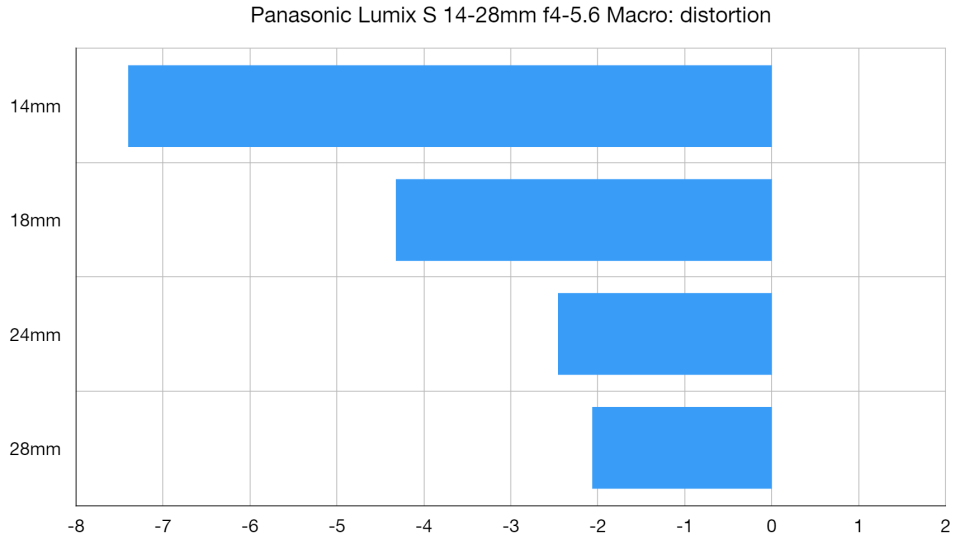
Barrel distortion is extreme at 14mm and still very noticeable at 18mm. By 24mm it's reached an acceptable level, but realistically you're going to want to enable in-camera distortion correction at all times - the lens has been engineered to rely on it.
Panasonic Lumix S 14-28mm F4-5.6 MACRO: Verdict
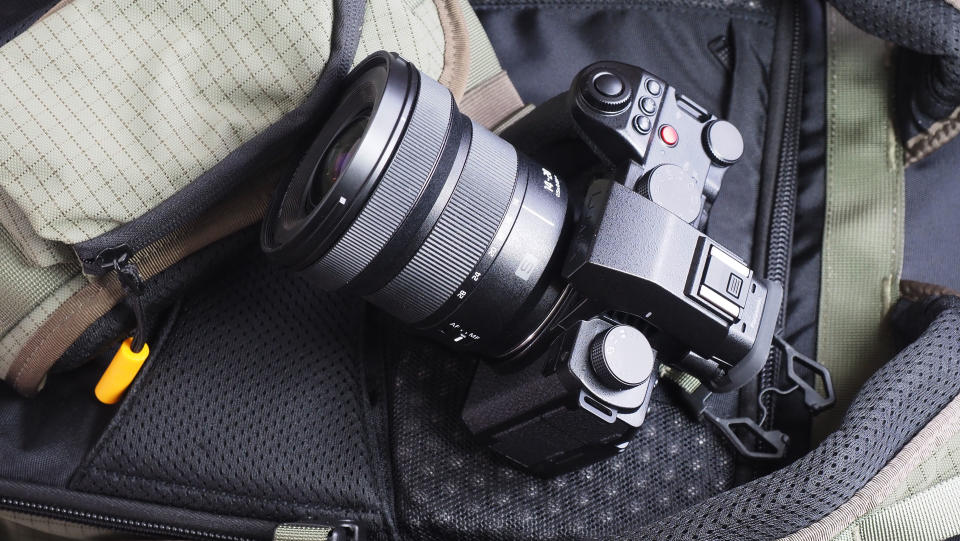
I wasn’t expecting to find the The Lumix S 14-28mm F4-5.6 an exciting lens to use. One look at the exterior confirms that this is a basic, no-frills lens, physically at least. But its small size, light weight and smooth, fluid operation did win me over. But not as much as the optical performance and overall image quality. This lens doesn’t quite deliver the razor sharp results of pro full frame lenses, but there’s not a whole lot in it, and it’s a whole lot cheaper. The main thing was that there weren’t any focal lengths or apertures I had to avoid, like there are on most inexpensive zooms. I could shoot at any settings without worrying that the edges wouldn’t be sharp. The Lumix S 14-28mm F4-5.6 has a fairly limited focal length/aperture envelope, but you can use all of it.
For me, the key thing is the price. This is not a lot to pay for an ultra-wide zoom with such consistent and reliable performance. And don’t forget you’re getting weather sealing and high-speed, high-precision autofocus too. The Lumix S 14-28mm F4-5.6 may not look or feel like the most exciting lens in the world, but it absolutely does the job, no question.
✅ Buy it if...
You want an affordable go-to ultra-wide zoom for any L-mount camera
You need a compact, light and easily balanced video lens for handheld or gimbal use
A variable f/4-5.6 maximum aperture isn't an issue
⛔️ Don't buy it if...
You need a premium pro-level constant-aperture zoom
If you only like lenses with physical aperture rings (not much choice in L-mount, unfortunately)
You're into astrophotography (you need a faster maximum aperture)
Panasonic Lumix S 14-28mm F4-5.6 MACRO: Alternatives

The bad news with the Panasonic Lumix S PRO 16-35mm f/4 is that while it's the top-tier ultra-wide Pro zoom in the Lumix S lens range, it is itself only an f/4. The good news is that it has a longer 16-35mm zoom range and that for a pro lens it’s actually really cheap, certainly when compared to the likes of Sony G Masters or Canon L-series lenses.

The Sigma 14-24mm f/2.8 DG DN Art offers a slightly shorter zoom range than the Panasonic, but comes with a constant f/2.8 maximum aperture and legendary Sigma ‘Art’ lens image quality. It’s a better lens for all-out light gathering and image quality, but it costs a good deal more than both the Panasonic Lumix S equivalents.

